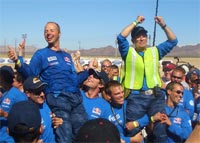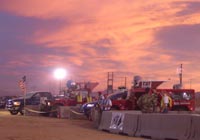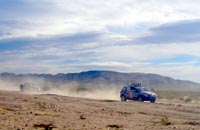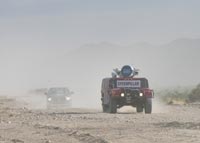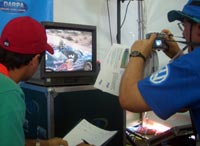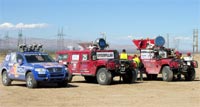Getting
Out There: |
Directory of all "Getting Out There" Articles> |
No
Drivers -- No Problem
Robots
Meet DARPA's "Grand Challenge"
by Mark Sedenquist
|
| More coverage
of the race: National Qualifying Event in Fontana, California by Mark Sedenquist Winning Strategies by robot analyst Mark Helmlinger Race Reminiscences by Megan Edwards |
Primm, Nevada, was the site of a truly historic road trip on Saturday, October 8th. At about 2:30 p.m., "Stanley," a driverless VW Diesel Touareg, crossed the finish line at the DARPA Grand Challenge after successfully negotiating a 131.5-mile desert course that looped around the Mojave Desert on both sides of Interstate 15 just south of Las Vegas. This was the second race sponsored by the Defense Advanced Research Projects Agency, offering a $2 million prize to the autonomous vehicle that could finish the course in ten hours or less. (The first Grand Challenge was held in March, 2004 - click here for the story.)
Twenty-three autonomous vehicles sponsored by universities, businesses, and individuals left the starting gates one by one as a spectacular dawn lit the sky behind Buffalo Bill's Casino at the Nevada-California border. They were embarking on a trek that would test their automotive design, the accuracy of their sensing equipment, and the intelligence of their software programs as they faced a number of off-highway challenges. The course featured nine cattle guard crossings, a steep bridge, three tunnels, straight runs across dry lake beds, twisty mountain grades, deep sand, dirt, pavement, and gravel roads, and a dangerous climb and descent over the 3,436-foot Beer Bottle Pass. Increasing the challenges of the course designed by the DARPA officials, Mother Nature added high winds and dust devils to the mix.
Nearly all the robot racers traveled farther than any of them were able to do in 2004, and five of them completed the entire course. In order of arrival, the bots who completed the trip were "Stanley" (sponsored by Stanford University), "H1ghlander" and "Sandstorm" (both sponsored by Carnegie-Mellon University), "KAT-5" (sponsored by the Gray Insurance Company) and the six-wheel drive mega-truck "TerraMax" (sponsored by the Oshkosh Truck company). TerraMax spent the night alone near mile 98 and finished the course on Sunday, bringing the Grand Challenge to a sixteen-ton end.
All the bots used a variety of GPS and inertial navigation systems. Radar and laser sensing devices "painted" complex 3-D maps of the topography through which they were driving. Then complex algorithm software made decisions about the speed, direction, and route that each would follow. As a spectator, it was difficult to comprehend the programming skill required to create software programs that could enable the bots to navigate roads that would task fully-sighted human drivers. One of the crowd favorites fell victim to a common problem faced by thousands of off-highway enthusiasts each year. A simple but fatal flat tire stopped "Dexter" (Deployable EXtreme Terrain Enabled Robot) at mile 97 late on Saturday.
As at the first DARPA event, an enthusiastic crowd cheered each bot as it took off into the unknown with only its artificial brain to guide it. In spite of mishaps and computer failures, it's amazing that over 20% of the vehicles completed the course, and all but two fared better that the best performer at the last race. Autonomous vehicle technology has come a long way in eighteen months.
Next week, RTA's robot analyst Mark Helmlinger will provide an overview of what worked and what didn't, and we'll have more pictures of the bots, their creators, and the only road race in history to boast "No Drivers -- No Problem."
Mark Sedenquist
October 9, 2005
(Links updated August 8, 2020, RTA)

